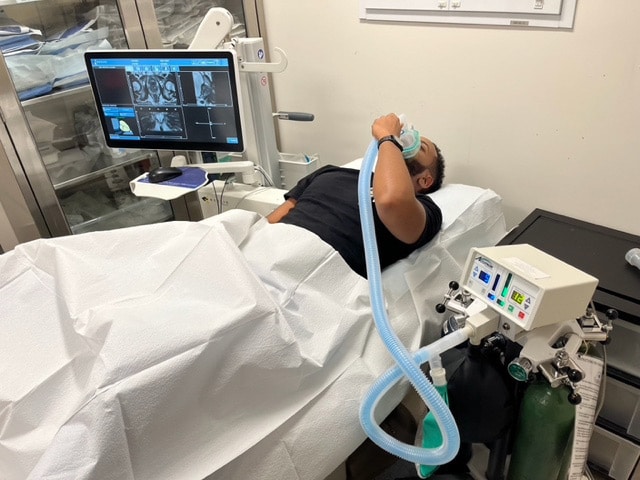An old dog — nitrous oxide — can learn new tricks, managing pain in men undergoing transrectal biopsies, researchers reported at the 2023 annual meeting of the American Urological Association.

Heidi Rayala, MD, PhD
"At concentrations of less than 50%, nitrous oxide is classified as a minimal sedative, making it a promising option for many urologic outpatient procedures such as prostate biopsies," said Heidi Rayala, MD, PhD, assistant professor of surgery at Harvard Medical School, in Boston, who helped conduct the study.
Nitrous oxide is best known as a pain medication and anesthetic during dental procedures and childbirth, after trauma, and in end-of-life care.
In the new study, Rayala and her colleagues at Harvard and Beth Israel-Deaconess Medical Center (BIDMC) randomly assigned 128 men to self-administered nitrous oxide (SANO) or oxygen as a placebo. Patients in the SANO group had a smaller change in post-biopsy pain score (Visual Analog Scale for pain, 0.43 vs 1.03; P = .03) and lower odds of experiencing pain during the procedure (odds ratio, 0.45; CI, 0.21-0.97; P = .04).
A comparison of anxiety scores in the two groups failed to find a statistically significant difference between SANO and placebo. However, more men who received nitrous oxide said they tolerated the procedure "better than expected" (61% vs. 41%; P = 0.02), according to the researchers.

A volunteer demonstrates the Nitrouseal system (Sedation Systems) at Brigham and Women’s Hospital.
Rayala said that the researchers used the Nitrouseal system (Sedation Systems), in which the patient holds a mask to their face and works with staff to adjust the gas levels to the desired amount. The system is governed to max out at 50% nitrous oxide, ensuring "minimal sedation concentrations, so anesthesia personnel are not required," she said.
"At levels of less than 50%, patients respond normally to verbal commands and maintain normal airway reflexes," Rayala added. "This provides an advantage in that patients do not require the presence of anesthesia personnel." And because the body eliminates the gas within about 5 minutes, patients do not require an escort home, she said.
This system is also self-scavenging to protect the operating urologist and other personnel from environmental exposure to nitrous oxide.
Rayala said that three patients (2.3%) found the mask uncomfortable, but in follow-up studies the clinicians have done a better job of preparing patients for the feeling of the mask, making a marked difference. Headaches and nausea are the most commonly reported complaints at concentrations above 50%.
"We did not have patients report headaches or nausea in new study (by the BIDMC group)," she said. This study has been submitted for publication.
Clinicians outside the United States have been quicker to embrace nitrous oxide for prostate procedures.
In a randomized controlled trial, researchers in Australia found no significant improvement in pain scores at 15 minutes from the use of nitrous oxide during transrectal biopsies; however, improvements were seen in patient-reported discomfort, overall experience, and willingness to undergo repeat biopsies.
Stephen McCombie, MD, a consultant at Perth Urology Clinic in Australia, who has been adapting the nitrous oxide protocol for transrectal biopsies to transperineal procedures, said that the Beth Israel study "adds to the evidence to support adjunct use of mild inhalational anesthetics and analgesics during prostate biopsies to improve the patient experience of the procedure."
He said that the role for these agents may grow with the global trend away from transrectal prostate biopsies and toward transperineal biopsies, largely driven by increasing rates of sepsis after transrectal biopsies.
"While transperineal biopsies can be more painful then transrectal biopsies when performed under local anesthesia, perhaps due to biopsies being taken through the highly sensate perineum as opposed to above the dentate line, optimization of the technique can significantly reduce the discomfort associated with the procedure, which may be further reduced with these agents," McCombie said.
"Studies indicate that transperineal biopsies can be more painful than the traditional transrectal biopsies," Rayala said. "We do offer transperineal biopsies at BIDMC, and we are gearing up to repeat the SANO study" for those patients.
Rayala and McCombie have disclosed no relevant financial relationships.
American Urological Association 2023 Annual Meeting. Presented May 1. Abstract MP76-18
Howard Wolinsky is a Chicago-based medical freelancer and a patient diagnosed with low-risk prostate cancer who has been on active surveillance since 2010. He is the editor of the Substack newsletter, TheActiveSurveillor.com.
For more news, follow Medscape on Facebook, Twitter, Instagram, and YouTube
Credits:
Lead image: Yailen26/Dreamstime
Image 1: BIDMC Media Services
Image 2: Sedation Systems
Medscape Medical News © 2023 WebMD, LLC
Send news tips to news@medscape.net.
Cite this: Prostate Biopsies a Laughing (Gas) Matter? - Medscape - May 01, 2023.









Comments